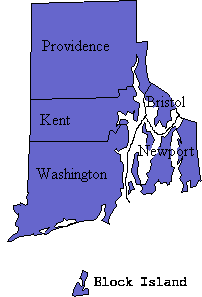 Roger Williams’ choice of Providence as the site of residence, and his ideas on civil government, were not unanimous favorites with the original settlers. A majority of the first settlers eventually left and moved southward, some to Pawtuxet, some to Warwick, some to Newport, and some to other places. Providence in 1645 claimed only 101 men capable of bearing arms (males over age 16), including the residents of Pawtuxet and Warwick. Hence, William Bucklin, as he settled, on or before 1645, in the area now known as Pawtucket, was settling in a area not overly populated.
Roger Williams’ choice of Providence as the site of residence, and his ideas on civil government, were not unanimous favorites with the original settlers. A majority of the first settlers eventually left and moved southward, some to Pawtuxet, some to Warwick, some to Newport, and some to other places. Providence in 1645 claimed only 101 men capable of bearing arms (males over age 16), including the residents of Pawtuxet and Warwick. Hence, William Bucklin, as he settled, on or before 1645, in the area now known as Pawtucket, was settling in a area not overly populated.
Those of you looking at the Bucklin family in Massachusetts and Rhode Island, in the 1600-1799 period, may be interested in comparing the Bucklin families with the “average” family in the early colonies. You will find that, generally, the Bucklin families tended to be smaller and the members live somewhat longer than the average, although not markedly different.
The following statistics are from the demographic tables in John Demos, A Little Commonwealth, Family Life in Plymouth Colony.
Average number of Children Born – About 8
Average number of Children Living to Age 21 – About 7
Life Expectancy in Plymouth Colony.
If you were age 21, you could expect to live to age 69 for men and 62 for women.
If you were age 40, you could expect to live to age 71 for men and age 70 for women.
If you were age 60, you could expect to live to age 76, whether a man or woman.
If you were age 80, you could expect to live to about age 85, whether a man or woman.
Mean age of men at time of first marriage: about 26
Mean age of women at time of first marriage: about 21
Rates of remarriage
34% of the men over age 50 had been married twice
25% of the men over age 50 had been married twice
Less than 1% of the women, and less than 8% of the men over age 50. pr or over 70, had been married three times.
In the 1600’s, Rhode Islanders farmed and fished, mostly to meet their own needs. By the early 1700’s, Rhode Island farmers were producing surplus livestock and crops, and used slave labor to do so. Leading agricultural products were corn, wool, cheese, and horses (including the famous crossbreed known as the Narragansett pacer). Agricultural produce, lumber, barrel staves, iron bars from bog iron, and fish were shipped mainly to the West Indies, with smaller amounts going to other colonies, England, and southern Europe. Ship building became a major industry, with more ships being built in New England before 1776 than in England.
In exchange for their goods, Rhode Island merchants obtained received commodities and money of various currencies they used to purchase manufactured products from England. The main product they received was molasses from the West Indies. This brought the triangular trade the New England colonies, Africa, and the West Indies. The molasses was made into rum at Newport and Providence. Merchants transported rum to Africa, where it was exchanged for black slaves. The next stop was generally the West Indies, where slaves were in great demand on vast sugar plantations. The slaves were exchanged for molasses, which was brought back to Rhode Island to be made into more rum.
This trade flourished during most of the 18th century, providing much of the wealth that made Newport a leading social and cultural center in the colonies. Newport also served as the colonies major slave trading center until 1774.
1708: First census taken; population 7,181
1730: Census taken; population 17,935.
1748: Census taken; population 32,773.
1755: Census taken; population 40,414.
1774: Census taken; population 57,707.
